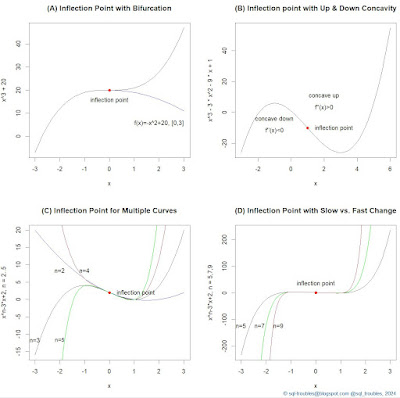Disclaimer: This post was created just for fun. No problem was hurt or solved
in the process!
Updated: 12-Jun-2024
On Problems
Everybody has at least a problem. If somebody doesn’t have a problem, he’ll
make one. If somebody can't make a problem, he can always find a problem. One
doesn't need to search long for finding a problem. Looking for a problem one
sees more problems.
Not having a problem can easily become a problem. It’s better to have a
problem than none. The none problem is undefinable, which makes it a
problem.
Avoiding a problem might lead you to another problem. Some problems are so
old, that's easier to ignore them.
In every big problem there’s a small problem trying to come out. Most problems
can be reduced to smaller problems. A small problem may hide a bigger
problem.
It’s better to solve a problem when is still small, however problems can be
perceived only when they grow bigger (big enough).
In the neighborhood of a problem there’s another problem getting closer.
Problems tend to attract each other.
Between two problems there’s enough place for a third to appear. The shortest
path between two problems is another problem.
Two problems that appear together in successive situations might be the parts
of the same problem.
A problem is more than the sum of its parts.
Any problem can be simplified to the degree that it becomes another
problem.
The complementary of a problem is another problem. At the intersection/reunion
of two problems lies another problem.
The inverse of a problem is another problem more complex than the initial
problem.
Defining a problem correctly is another problem. A known problem doesn’t make
one problem less.
When a problem seems to be enough, a second appears. A problem never comes
alone. The interplay of the two problems creates a third.
Sharing the problems with somebody else just multiplies the number of
problems.
Problems multiply beyond necessity. Problems multiply beyond our expectations.
Problems multiply faster than we can solve them.
Having more than one problem is for many already too much. Between many big
problems and an infinity of problems there seem to be no big difference.
Many small problems can converge toward a bigger problem. Many small problems
can also diverge toward two bigger problems.
When neighboring problems exist, people tend to isolate them. Isolated
problems tend to find other ways to surprise.
Several problems aggregate and create bigger problems that tend to suck within
the neighboring problems.
If one waits long enough some problems will solve themselves or it will get
bigger. Bigger problems exceed one's area of responsibility.
One can get credit for a self-created problem. It takes only a good problem to
become famous.
A good problem can provide a lifetime. A good problem has the tendency to kick
back where it hurts the most. One can fall in love with a good problem.
One should not theorize before one has a (good) problem. A problem can lead to
a new theory, while a theory brings with it many more problems.
If the only tool you have is a hammer, every problem will look like a nail.
(paraphrasing Abraham H Maslow)
Any field of knowledge can be covered by a set of problems. A field of
knowledge should be learned by the problems it poses.
A problem thoroughly understood is always fairly simple, but unfairly complex.
(paraphrasing Charles F Kettering)
The problem solver created usually the problem.
Problem Solving
Break a problem in two to solve it easier. Finding how to break a problem is
already another problem. Deconstructing a problem to its parts is no guarantee
for solving the problem.
Every problem has at least two solutions from which at least one is wrong.
It’s easier to solve the wrong problem.
It’s easier to solve a problem if one knows the solution already. Knowing a
solution is not a guarantee for solving the problem.
Sometimes a problem disappears faster than one can find a solution.
If a problem has two solutions, more likely a third solution exists.
Solutions can be used to generate problems. The design of a problem seldom
lies in its solutions.
The solution of a problem can create at least one more problem.
One can solve only one problem at a time.
Unsolvable problems lead to problematic approximations. There's always a
better approximation, one just needs to find it. One needs to be o know when
to stop searching for an approximation.
There's not only a single way for solving a problem. Finding another way for
solving a problem provides more insight into the problem. More insight
complicates the problem unnecessarily.
Solving a problem is a matter of perspective. Finding the right perspective is
another problem.
Solving a problem is a matter of tools. Searching for the right tool can be a
laborious process.
Solving a problem requires a higher level of consciousness than the level that
created it. (see Einstein) With the increase complexity of the problems one an
run out of consciousness.
Trying to solve an old problem creates resistance against its
solution(s).
The premature optimization of a problem is the root of all evil. (paraphrasing
Donald Knuth)
A great discovery solves a great problem but creates a few others on its way.
(paraphrasing George Polya)
Solving the symptoms of a problem can prove more difficult that solving the
problem itself.
A master is a person who knows the solutions to his problems. To learn the
solutions to others' problems he needs a pupil.
"The final test of a theory is its capacity to solve the problems which
originated it." (George Dantzig) It's easier to theorize if one has a set of
problems.
A problem is defined as a gap between where you are and where you want to be,
though nobody knows exactly where he is or wants to be.
Complex problems are the problems that persist - so are minor ones.
"The problems are solved, not by giving new information, but by arranging what
we have known since long." (Ludwig Wittgenstein, 1953) Some people are just
lost in rearranging.
Solving problems is a practical skill, but impractical endeavor. (paraphrasing
George Polya)
"To ask the right question is harder than to answer it." (Georg Cantor) So
most people avoid asking the right question.
Solve more problems than you create.
They Said It
"A great many problems do not have accurate answers, but do have approximate
answers, from which sensible decisions can be made." (Berkeley's Law)
"A problem is an opportunity to grow, creating more problems. [...] most
important problems cannot be solved; they must be outgrown." (Wayne Dyer)
"A system represents someone's solution to a problem. The system doesn't solve
the problem." (John Gall, 1975)
"As long as a branch of science offers an abundance of problems, so long is it
alive." (David Hilbert)
"Complex problems have simple, easy to understand, wrong answers." [Grossman's
Misquote]
"Every solution breeds new problems." [Murphy's laws]
"Given any problem containing n equations, there will be n+1 unknowns."
[Snafu]
"I have not seen any problem, however complicated, which, when you looked at
it in the right way, did not become still more complicated." (Paul Anderson)
"If a problem causes many meetings, the meetings eventually become more
important than the problem." (Hendrickson’s Law)
"If you think the problem is bad now, just wait until we’ve solved it."
(Arthur Kasspe) [Epstein’s Law]
"Inventing is easy for staff outfits. Stating a problem is much harder.
Instead of stating problems, people like to pass out half- accurate statements
together with half-available solutions which they can't finish and which they
want you to finish." [Katz's Maxims]
"It is better to do the right problem the wrong way than to do the wrong
problem the right way." (Richard Hamming)
"Most problems have either many answers or no answer. Only a few problems have
a single answer." [Berkeley's Law]
"Problems worthy of attack prove their worth by fighting back." (Piet Hein)
Rule of Accuracy: "When working toward the solution of a problem, it always
helps if you know the answer."
Corollary: "Provided, of course, that you
know there is a problem."
"Some problems are just too complicated for rational logical solutions. They
admit of insights, not answers." (Jerome B Wiesner, 1963)
"Sometimes, where a complex problem can be illuminated by many tools, one can
be forgiven for applying the one he knows best." [Screwdriver Syndrome]
"The best way to escape from a problem is to solve it." (Brendan Francis)
"The chief cause of problems is solutions." [Sevareid's Law]
"The first step of problem solving is to understand the existing conditions."
(Kaoru Ishikawa)
"The human race never solves any of its problems, it only outlives them."
(David Gerrold)
"The most fruitful research grows out of practical problems." (Ralph B
Peck)
"The problem-solving process will always break down at the point at which it
is possible to determine who caused the problem." [Fyffe's Axiom]
"The worst thing you can do to a problem is solve it completely." (Daniel
Kleitman)
"The easiest way to solve a problem is to deny it exists." (Isaac Asimov)
"The solution to a problem changes the problem." [Peers's Law]
"There is a solution to every problem; the only difficulty is finding it."
[Evvie Nef's Law]
"There is no mechanical problem so difficult that it cannot be solved by brute
strength and ignorance. [William's Law]
"Today's problems come from yesterday’s 'solutions'." (Peter M Senge, 1990)
"While the difficulties and dangers of problems tend to increase at a
geometric rate, the knowledge and manpower qualified to deal with these
problems tend to increase linearly." [Dror's First Law]
"You are never sure whether or not a problem is good unless you actually solve
it." (Mikhail Gromov)
Previous Post <<||>>
Next Post
More quotes on Problem solving at
QuotableMath.blogpost.com
Resources:
Murphy's laws and corollaries (link)













